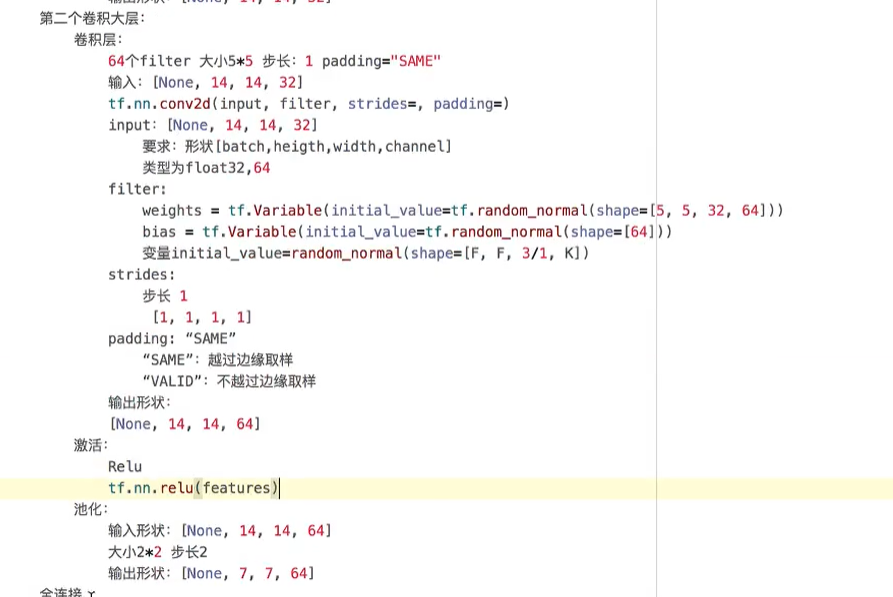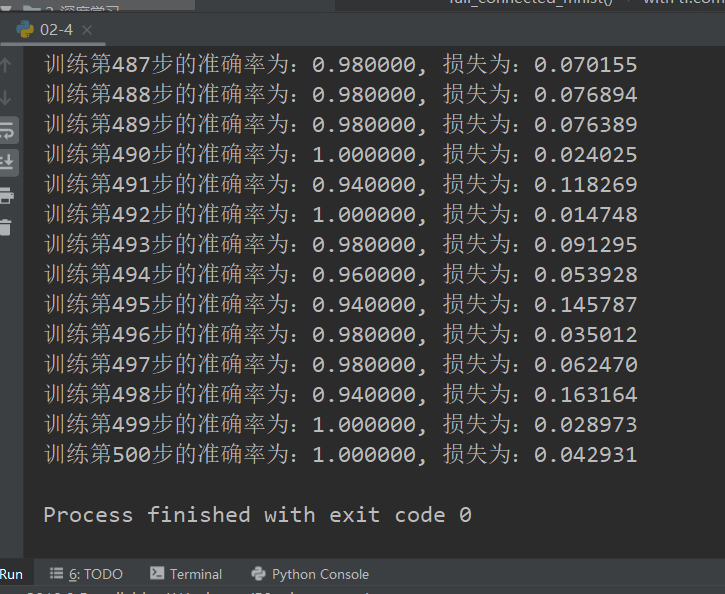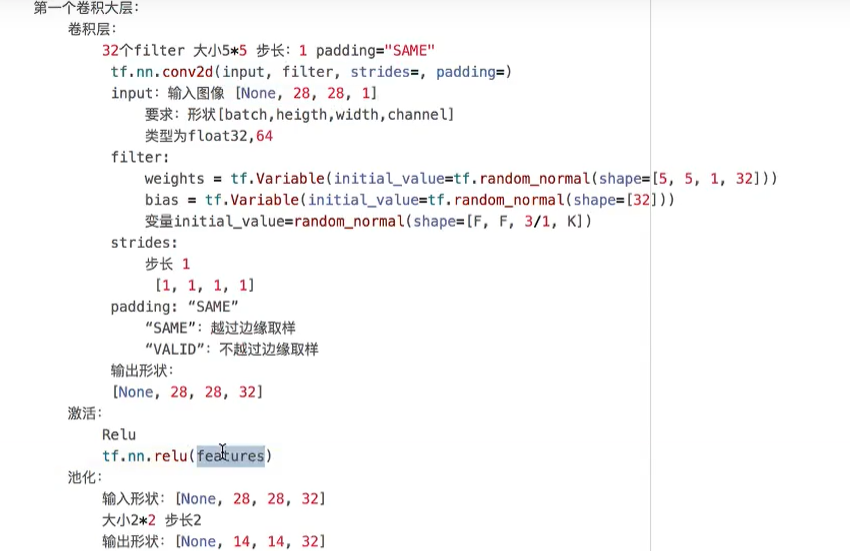网络结构:

网络设计:

代码:
import tensorflow as tf from tensorflow.examples.tutorials.mnist import input_data tf.compat.v1.disable_eager_execution() # 1、利用数据,在训练的时候实时提供数据 # mnist手写数字数据在运行时候实时提供给给占位符 tf.compat.v1.app.flags.DEFINE_integer("is_train", 1, "指定是否是训练模型,还是拿数据去预测") FLAGS = tf.compat.v1.app.flags.FLAGS def create_weights(shape): return tf.Variable(initial_value=tf.compat.v1.random_normal(shape=shape, stddev=0.01)) def create_model(x): """ 构建卷积神经网络 :param x: :return: """ # 1)第一个卷积大层 with tf.compat.v1.variable_scope("conv1"): # 卷积层 # 将x[None, 784]形状进行修改 input_x = tf.reshape(x, shape=[-1, 28, 28, 1]) # 定义filter和偏置 conv1_weights = create_weights(shape=[5, 5, 1, 32]) conv1_bias = create_weights(shape=[32]) conv1_x = tf.compat.v1.nn.conv2d(input=input_x, filter=conv1_weights, strides=[1, 1, 1, 1], padding="SAME") + conv1_bias # 激活层 relu1_x = tf.nn.relu(conv1_x) # 池化层 pool1_x = tf.compat.v1.nn.max_pool(value=relu1_x, ksize=[1, 2, 2, 1], strides=[1, 2, 2, 1], padding="SAME") # 2)第二个卷积大层 with tf.compat.v1.variable_scope("conv2"): # 卷积层 # 定义filter和偏置 conv2_weights = create_weights(shape=[5, 5, 32, 64]) conv2_bias = create_weights(shape=[64]) conv2_x = tf.compat.v1.nn.conv2d(input=pool1_x, filter=conv2_weights, strides=[1, 1, 1, 1], padding="SAME") + conv2_bias # 激活层 relu2_x = tf.compat.v1.nn.relu(conv2_x) # 池化层 pool2_x = tf.compat.v1.nn.max_pool(value=relu2_x, ksize=[1, 2, 2, 1], strides=[1, 2, 2, 1], padding="SAME") # 3)全连接层 with tf.compat.v1.variable_scope("full_connection"): # [None, 7, 7, 64]->[None, 7 * 7 * 64] # [None, 7 * 7 * 64] * [7 * 7 * 64, 10] = [None, 10] x_fc = tf.reshape(pool2_x, shape=[-1, 7 * 7 * 64]) weights_fc = create_weights(shape=[7 * 7 * 64, 10]) bias_fc = create_weights(shape=[10]) y_predict = tf.matmul(x_fc, weights_fc) + bias_fc return y_predict def full_connected_mnist(): """ 单层全连接神经网络识别手写数字图片 特征值:[None, 784] 目标值:one_hot编码 [None, 10] :return: """ mnist = input_data.read_data_sets("../mnist_data/", one_hot=True) # 1、准备数据 # x [None, 784] y_true [None. 10] with tf.compat.v1.variable_scope("mnist_data"): x = tf.compat.v1.placeholder(tf.float32, [None, 784]) y_true = tf.compat.v1.placeholder(tf.int32, [None, 10]) y_predict = create_model(x) # 3、softmax回归以及交叉熵损失计算 with tf.compat.v1.variable_scope("softmax_crossentropy"): # labels:真实值 [None, 10] one_hot # logits:全脸层的输出[None,10] # 返回每个样本的损失组成的列表 loss = tf.reduce_mean(tf.nn.softmax_cross_entropy_with_logits(labels=y_true, logits=y_predict)) # 4、梯度下降损失优化 with tf.compat.v1.variable_scope("optimizer"): # 学习率 train_op = tf.compat.v1.train.AdamOptimizer(0.001).minimize(loss) # 5、得出每次训练的准确率(通过真实值和预测值进行位置比较,每个样本都比较) with tf.compat.v1.variable_scope("accuracy"): equal_list = tf.equal(tf.argmax(y_true, 1), tf.argmax(y_predict, 1)) accuracy = tf.reduce_mean(tf.cast(equal_list, tf.float32)) # (2)收集要显示的变量 # 先收集损失和准确率 #tf.summary.scalar("losses", loss) #tf.summary.scalar("acc", accuracy) # 初始化变量op init_op = tf.compat.v1.global_variables_initializer() # (3)合并所有变量op #merged = tf.compat.v1.summary.merge_all() # 创建模型保存和加载 #saver = tf.compat.v1.train.Saver() # 开启会话去训练 with tf.compat.v1.Session() as sess: # 初始化变量 sess.run(init_op) # (1)创建一个events文件实例 #file_writer = tf.compat.v1.summary.FileWriter("../tmp/summary/", graph=sess.graph) # 加载模型 # if os.path.exists("./tmp/modelckpt/checkpoint"): # saver.restore(sess, "./tmp/modelckpt/fc_nn_model") if FLAGS.is_train == 1: # 循环步数去训练 for i in range(500): # 获取数据,实时提供 # 每步提供50个样本训练 mnist_x, mnist_y = mnist.train.next_batch(50) # 运行训练op sess.run(train_op, feed_dict={x: mnist_x, y_true: mnist_y}) print("训练第%d步的准确率为:%f, 损失为:%f " % (i+1, sess.run(accuracy, feed_dict={x: mnist_x, y_true: mnist_y}), sess.run(loss, feed_dict={x: mnist_x, y_true: mnist_y}) ) ) # 运行合变量op,写入事件文件当中 #summary = sess.run(merged, feed_dict={x: mnist_x, y_true: mnist_y}) #file_writer.add_summary(summary, i) # if i % 100 == 0: # saver.save(sess, "./tmp/modelckpt/fc_nn_model") else: # 如果不是训练,我们就去进行预测测试集数据 for i in range(100): # 每次拿一个样本预测 mnist_x, mnist_y = mnist.test.next_batch(1) print("第%d个样本的真实值为:%d, 模型预测结果为:%d" % ( i+1, tf.argmax(sess.run(y_true, feed_dict={x: mnist_x, y_true: mnist_y}), 1).eval(), tf.argmax(sess.run(y_predict, feed_dict={x: mnist_x, y_true: mnist_y}), 1).eval() ) ) return None if __name__ == "__main__": full_connected_mnist()

